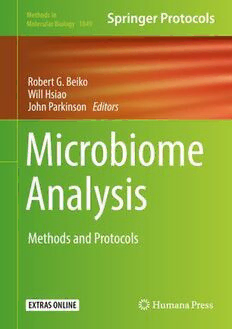Table Of ContentMethods in
Molecular Biology 1849
Robert G. Beiko
Will Hsiao
John Parkinson Editors
Microbiome
Analysis
Methods and Protocols
M M B
ETHODS IN OLECULAR IO LO GY
SeriesEditor
JohnM.Walker
School of Lifeand MedicalSciences
University ofHertfordshire
Hatfield, Hertfordshire,AL109AB,UK
Forfurther volumes:
http://www.springer.com/series/7651
Microbiome Analysis
Methods and Protocols
Edited by
Robert G. Beiko
Faculty of Computer Science, Dalhousie University, Halifax, NS, Canada
Will Hsiao
Department of Pathology & Laboratory Medicine, University of British Columbia,
Vancouver, BC, Canada
John Parkinson
Program in Molecular Medicine, The Hospital for Sick Children, Toronto, ON, Canada;
Department of Biochemistry and Department of Molecular Genetics, University of Toronto,
Toronto, ON, Canada
Editors
RobertG.Beiko WillHsiao
FacultyofComputerScience DepartmentofPathology
DalhousieUniversity &LaboratoryMedicine
Halifax,NS,Canada UniversityofBritishColumbia
Vancouver,BC,Canada
JohnParkinson
PrograminMolecularMedicine
TheHospitalforSickChildren
Toronto,ON,Canada
DepartmentofBiochemistry
andDepartmentofMolecularGenetics
UniversityofToronto
Toronto,ON,Canada
ISSN1064-3745 ISSN1940-6029 (electronic)
MethodsinMolecularBiology
ISBN978-1-4939-8726-9 ISBN978-1-4939-8728-3 (eBook)
https://doi.org/10.1007/978-1-4939-8728-3
LibraryofCongressControlNumber:2018955280
©SpringerScience+BusinessMedia,LLC,partofSpringerNature2018
Thisworkissubjecttocopyright.AllrightsarereservedbythePublisher,whetherthewholeorpartofthematerialis
concerned,specificallytherightsoftranslation,reprinting,reuseofillustrations,recitation,broadcasting,reproduction
onmicrofilmsorinanyotherphysicalway,andtransmissionorinformationstorageandretrieval,electronicadaptation,
computersoftware,orbysimilarordissimilarmethodologynowknownorhereafterdeveloped.
Theuseofgeneraldescriptivenames,registerednames,trademarks,servicemarks,etc.inthispublicationdoesnotimply,
evenintheabsenceofaspecificstatement,thatsuchnamesareexemptfromtherelevantprotectivelawsandregulations
andthereforefreeforgeneraluse.
Thepublisher,theauthors,andtheeditorsaresafetoassumethattheadviceandinformationinthisbookarebelievedto
betrueandaccurateatthedateofpublication.Neitherthepublishernortheauthorsortheeditorsgiveawarranty,
expressorimplied,withrespecttothematerialcontainedhereinorforanyerrorsoromissionsthatmayhavebeenmade.
Thepublisherremainsneutralwithregardtojurisdictionalclaimsinpublishedmapsandinstitutionalaffiliations.
This Humana Press imprint is published by the registered company Springer Science+Business Media, LLC, part of
SpringerNature.
Theregisteredcompanyaddressis:233SpringStreet,NewYork,NY10013,U.S.A.
Preface
The microbiome, coined by Lederberg and McCray as “...the ecological community of
commensal,symbiotic,andpathogenicmicroorganismsthatliterallyshareourbodyspace”
[1], draws together a remarkable number of disciplines with the overarching goal of
understanding and ultimately harnessing the workings of microbial systems. True to the
initial conception of the term, the humanmicrobiome continues to beintensively studied,
but microbial samples have been collected from nearly every imaginable habitat on Earth,
from the upper atmosphere to the seabed subsurface, from hot springs to glacier ice, and
fromnematodegutstowhalecarcasses.
Microbiome analysis makes frequent use of a common set of tools to address many
pertinentquestions.Acommonworkflowformicrobiomeanalysislookssomethinglikethis:
collect sample (e.g., soil, water, stool), extract DNA, perform DNA sequencing, and use
bioinformaticstoolstodescribeimportantpropertiesofthemicrobiome.Thispipelinehas
beenappliedtohugenumbersofsamplesfromadiversearrayofenvironments.Inparticular,
the targeted sequencing via polymerase chain reaction (PCR) amplification of “marker”
genes that are seen as diagnostic of different types of microorganisms has seen widespread
use. The workhorse of microbial diversity has thus far been the 16S ribosomal RNA gene,
which has been the subject of intensive protocol development: see for example the Earth
Microbiome Project protocols [2], and a detailed evaluation of 16S sequencing on the
Illuminasequencingplatforms[3].However,whilecapturingthetaxonomiccompositionofa
microbialcommunity,marker-genesequencingislimitedinitsabilitytorevealthediversity
of functionspresent,requiringtheapplicationofalternativeapproaches.
Gaininganaccurateandrelevantpictureofthemicrobiomerequirescarefulexperimen-
tal design, and the first part of our book focuses on the profiling of different habitats and
elements of biodiversity. The procedures to collect representative and uncontaminated
samples can be highly complex; one need look no further than Chapter 1 for an example
of the challenges associated with collecting microbial samples from the deep subsurface.
DNAsequencingmightbeseenasthefoundationofmicrobialcommunityanalysis,evenif
arguably the first such analysis was done with RNA rather than DNA sequencing in the
famous Octopus Spring study [4]. However, other “meta-omic” methods that consider
messenger RNA transcripts, protein products, or metabolite levels can reveal a great deal
more about microbial activities in a particular habitat. The combination of multiple such
strategiescanbeespeciallypowerful,asillustratedbytheuseofDNAsequencingtosupport
targetedmetaproteomics(Chapter6).
The remainder of this volume addresses the computational challenges of microbiome
analysis.Animmensenumberofalgorithmsandsoftwarepackageshavebeendevelopedfor
thetask,andevenseeminglysimplequestionsas“whatisthebiodiversitypresentinagiven
sample?” may not bestraightforward, as exemplified byChapter 10. Atthe same time,the
rich information generated from these samples is driving the development of innovative
toolsandpipelineswiththeabilitytogeneratenoveldatatypesandaddressnewquestions,
suchastherecoveryofcompletegenomesfrommetagenomes(Chapter14),andtheuseof
networkapproachestoidentifypatternsofmicrobialassociation(Chapter17).
Althoughnobookonmicrobiomeanalysiscanbeexhaustive,inpreparingour volume
wehavesoughttoconveywhatmightbeseenasstandardpracticeinthefield(totheextent
v
vi Preface
anythingcanbeclaimedassuch!),whilealsohighlightingtechniquesatthefrontiersofthe
field that challenge standard practice. Reflecting the continued dominance of marker-gene
approaches,theQIIMEpackage[5]recentlyreceiveditsten-thousandthcitation:therecent
release of the second version of this software is notable because it is developed in a
completely different framework, and because it upends some of the tools and techniques
thathaveheretoforeservedasitsdefaults(seeChapter8).
By defining procedures in precise terms, the Methods in Molecular Biology series con-
tributestothereproducibilityofexperiments.However,reproducibilityinbioinformaticsis
abigconcern[6],withseveralmovingpartsincludingdatabaseversions,softwareupdates,
andparametersettings.Comparingnewmethodstoexistingonesdemandsthatfinalresults
and all intermediate steps can be regenerated. The last few years have seen significant
advances in reproducibility through means such as automated workflow tools including
Galaxy, interactive code tools such as Jupyter Notebooks, and repositories with version
control,themostnotableexampleofwhichiscurrentlyGithub.Wearepleasedthatmanyof
our authors have provided examples that make use of these tools, which will make it
considerablyeasier for readerstoperformanalysesinaconsistentmanner.
Itremainsonlyforustothanktheindividualswhohavecontributedtheirtimeandhard
worktopreparingahighlydiverseandengagingsetofchapters.WearealsogratefultoJohn
Walker for theoriginalinvitationtopreparethisbook.
Halifax,NS,Canada RobertG.Beiko
Vancouver,BC,Canada WillHsiao
Toronto,ON,Canada JohnParkinson
References
1. Lederberg J, McCray AT (2001) Ome SweetOmics—a genealogical treasury of words.
Scientist15;8
2. Earth Microbiome Project. Protocols and Standards. http://www.earthmicrobiome.
org/protocols-and-standards/.Accessed3March2018
3. Caporaso JG, Lauber CL, Walters WA, et al (2012) Ultra-high-throughput microbial
communityanalysisontheIlluminaHiSeqandMiSeqplatforms.ISMEJ6:1621
4. StahlDA,LaneDJ,OlsenGJ,etal(1985)CharacterizationofaYellowstonehotspring
microbialcommunityby5SrRNAsequences.ApplEnvironMicrobiol49:1379–1384
5. Caporaso JG, Kuczynski J, Stombaugh J et al (2010). QIIME allows analysis of high-
throughputcommunitysequencingdata.NatMethods7:335
6. Sandve GK, Nekrutenko A, Taylor J et al (2013) Ten simple rules for reproducible
computationalresearch.PLoSComputBiol9:e1003285
Contents
Preface ..................................................................... v
Contributors................................................................. ix
1 CharacterizingtheDeepTerrestrialSubsurfaceMicrobiome ................. 1
RebeccaA.Daly,KellyC.Wrighton,andMichaelJ.Wilkins
2 FreshwaterViromes:FromSamplingtoEvaluation ......................... 17
CatherinePutonti,Zo¨eDiener,andSiobhanC.Watkins
3 CharacterizationofEukaryoticMicrobiomeUsing18S
AmpliconSequencing ................................................... 29
AnaPopovicandJohnParkinson
4 CultureandMolecularProfilingoftheRespiratoryTractMicrobiota.......... 49
FionaJ.Whelan,LauraRossi,JenniferC.Stearns,
andMichaelG.Surette
5 MethodsandStrategiestoExaminetheHumanBreastmilkMicrobiome ...... 63
LaurenLeMay-Nedjelski,JuliaCopeland,PaulineW.Wang,
JamesButcher,SharonUnger,AlainStintzi,andDeborahL.O’Connor
6 QuantificationofVitaminB -RelatedProteinsinMarine
12
MicrobialSystemsUsingSelectedReactionMonitoring
MassSpectrometry...................................................... 87
ErinM.Bertrand
7 Single-CellGenomicsofMicrobialDarkMatter ............................ 99
ChristianRinke
8 16SrRNAGeneAnalysiswithQIIME2 ................................... 113
MichaelHallandRobertG.Beiko
9 Processinga16SrRNASequencingDatasetwiththeMicrobiome
HelperWorkflow........................................................ 131
GavinM.Douglas,Andre´M.Comeau,andMorganG.I.Langille
10 NormalizationofMicrobiomeProfilingData............................... 143
PaulJ.McMurdie
11 PredictingtheFunctionalPotentialoftheMicrobiome
fromMarkerGenesUsingPICRUSt...................................... 169
GavinM.Douglas,RobertG.Beiko,andMorganG.I.Langille
12 MetagenomeAssemblyandContigAssignment ............................ 179
QingpengZhang
13 FromRNA-seqtoBiologicalInference:UsingCompositional
DataAnalysisinMeta-Transcriptomics .................................... 193
JeanM.MacklaimandGregoryB.Gloor
14 SubsampledAssembliesandHybridNucleotide
Composition/DifferentialCoverageBinningforGenome-Resolved
Metagenomics.......................................................... 215
LauraA.Hug
vii
viii Contents
15 TranskingdomNetworks:ASystemsBiologyApproachtoIdentify
CausalMembersofHost–MicrobiotaInteractions .......................... 227
RichardR.Rodrigues,NataliaShulzhenko,andAndreyMorgun
16 ConstructingandAnalyzingMicrobiomeNetworksinR .................... 243
MehdiLayeghifard,DavidM.Hwang,andDavidS.Guttman
17 BayesianInferenceofMicrobialCommunityStructure
fromMetagenomicDataUsingBioMiCo.................................. 267
KatherineA.Dunn,KatelynAndrews,RanaO.Bashwih,
andJosephP.Bielawski
18 AnalyzingMetabolicPathwaysinMicrobiomes............................. 291
MobolajiAdeolu,JohnParkinson,andXuejianXiong
19 SparseTreatment-EffectModelforTaxonIdentification
withHigh-DimensionalMetagenomicData................................ 309
ZhenqiuLiuandShiliLin
Index ...................................................................... 319
Contributors
MOBOLAJI ADEOLU (cid:1) PrograminMolecularMedicine,TheHospitalforSickChildren,
Toronto,ON,Canada
KATELYNANDREWS (cid:1) DepartmentofMathematicsandStatistics,DalhousieUniversity,
Halifax,NS,Canada
RANAO.BASHWIH (cid:1) DepartmentofMathematicsandStatistics,DalhousieUniversity,
Halifax,NS,Canada
ROBERTG.BEIKO (cid:1) FacultyofComputerScience,DalhousieUniversity,Halifax,NS,
Canada
ERINM.BERTRAND (cid:1) DepartmentofBiology,DalhousieUniversity,Halifax,NS,Canada
JOSEPH P.BIELAWSKI (cid:1) DepartmentofMathematicsandStatistics,DalhousieUniversity,
Halifax,NS,Canada
JAMESBUTCHER (cid:1) OttawaInstituteofSystemsBiology,Ottawa,ON,Canada;Departmentof
MicrobiologyandImmunology,UniversityofOttawa,Ottawa,ON,Canada
ANDRE´ M.COMEAU (cid:1) IntegratedMicrobiomeResource,DalhousieUniversity,Halifax,NS,
Canada
JULIACOPELAND (cid:1) Centrefor theAnalysisofGenomeEvolutionandFunction,Universityof
Toronto,Toronto,ON,Canada
REBECCAA.DALY (cid:1) DepartmentofMicrobiology,TheOhioStateUniversity,Columbus,OH,
USA
ZOE¨ DIENER (cid:1) DepartmentofBiology,NewMexicoInstituteforMiningandTechnology,
Socorro,NM,USA
GAVINM.DOUGLAS (cid:1) DepartmentofMicrobiologyandImmunology,DalhousieUniversity,
Halifax,NS,Canada
KATHERINEA.DUNN (cid:1) DepartmentofMathematicsandStatistics,DalhousieUniversity,
Halifax,NS,Canada
GREGORYB.GLOOR (cid:1) DepartmentofBiochemistry,SchulichSchoolofMedicineand
Dentistry,TheUniversityofWesternOntario,London,ON,Canada;CanadianCentre
forHumanMicrobiomeandProbioticResearch,LawsonHealthSciencesCentre,London,
ON,Canada
DAVIDS.GUTTMAN (cid:1) DepartmentofCellandSystemsBiology,UniversityofToronto,Toronto,
ON,Canada;Centrefor theAnalysisofGenomeEvolutionandFunction,Universityof
Toronto,Toronto,ON,Canada
MICHAELHALL (cid:1) DalhousieUniversity,Halifax,NS,Canada
LAURA A.HUG (cid:1) DepartmentofBiology,UniversityofWaterloo,Waterloo,ON,Canada
DAVIDM.HWANG (cid:1) DepartmentofPathology,UniversityHealthNetwork,Toronto,ON,
Canada;DepartmentofLaboratoryMedicineandPathobiology,UniversityofToronto,
Toronto,ON,Canada
MORGANG.I.LANGILLE (cid:1) DepartmentofMicrobiologyandImmunology,Dalhousie
University,Halifax,NS,Canada;IntegratedMicrobiomeResource,DalhousieUniversity,
Halifax,NS,Canada;DepartmentofPharmacology,DalhousieUniversity,Halifax,NS,
Canada
MEHDILAYEGHIFARD (cid:1) DepartmentofCellandSystemsBiology,UniversityofToronto,
Toronto,ON,Canada
ix
x Contributors
LAUREN LEMAY-NEDJELSKI (cid:1) FacultyofMedicine,DepartmentofNutritionalSciences,
UniversityofToronto,Toronto,ON,Canada;TranslationalMedicine,TheHospitalfor
SickChildren,Toronto,ON,Canada
SHILI LIN (cid:1) DepartmentofStatistics,TheOhioStateUniversity,Columbus,OH,USA
ZHENQIU LIU (cid:1) SamuelOschinComprehensiveCancerInstitute,Cedars-SinaiMedical
Center,LosAngeles,CA,USA
JEANM.MACKLAIM (cid:1) DepartmentofBiochemistry,SchulichSchoolofMedicineandDentistry,
TheUniversityofWesternOntario,London,ON,Canada;CanadianCentreforHuman
MicrobiomeandProbioticResearch,LawsonHealthSciencesCentre,London,ON,Canada
PAULJ.MCMURDIE (cid:1) WholeBiome,Inc.,SanFrancisco,CA,USA
ANDREYMORGUN (cid:1) CollegeofPharmacy,OregonStateUniversity,Corvallis,OR,USA
DEBORAH L.O’CONNOR (cid:1) FacultyofMedicine,DepartmentofNutritionalSciences,
UniversityofToronto,Toronto,ON,Canada;TranslationalMedicine,TheHospitalfor
SickChildren,Toronto,ON,Canada;DepartmentofPediatrics,MountSinaiHospital,
Toronto,ON,Canada
JOHNPARKINSON (cid:1) PrograminMolecularMedicine,TheHospitalforSickChildren,Toronto,
ON,Canada;DepartmentofBiochemistryandDepartmentofMolecularGenetics,
UniversityofToronto,Toronto,ON,Canada
ANAPOPOVIC (cid:1) PrograminMolecularMedicine,TheHospitalforSickChildren,Toronto,
ON,Canada;DepartmentofBiochemistry,UniversityofToronto,Toronto,ON,Canada
CATHERINEPUTONTI (cid:1) DepartmentofBiology,LoyolaUniversityChicago,Chicago,IL,USA;
DepartmentofComputerScience,LoyolaUniversityChicago,Chicago,IL,USA;
BioinformaticsProgram,LoyolaUniversityChicago,Chicago,IL,USA;Departmentof
MicrobiologyandImmunology,StritchSchoolofMedicine,LoyolaUniversityChicago,
Maywood,IL,USA
CHRISTIANRINKE (cid:1) AustralianCentreforEcogenomics,UniversityofQueensland,Brisbane,
QLD,Australia
RICHARDR.RODRIGUES (cid:1) CollegeofPharmacy,OregonStateUniversity,Corvallis,OR,USA
LAURA ROSSI (cid:1) DepartmentofBiochemistryandBiomedicalSciences,McMasterUniversity,
Hamilton,ON,Canada
NATALIA SHULZHENKO (cid:1) CollegeofVeterinaryMedicine,OregonStateUniversity,Corvallis,
OR,USA
JENNIFERC.STEARNS (cid:1) DepartmentofMedicine,McMasterUniversity,Hamilton,ON,
Canada
ALAINSTINTZI (cid:1) OttawaInstituteofSystemsBiology,Ottawa,ON,Canada;Departmentof
MicrobiologyandImmunology,UniversityofOttawa,Ottawa,ON,Canada
MICHAELG.SURETTE (cid:1) DepartmentofMedicine,McMasterUniversity,Hamilton,ON,
Canada
SHARONUNGER (cid:1) TranslationalMedicine,TheHospitalforSickChildren,Toronto,ON,
Canada;FacultyofMedicine,DepartmentofPediatrics,UniversityofToronto,Toronto,
ON,Canada;DepartmentofPediatrics,MountSinaiHospital,Toronto,ON,Canada
PAULINEW.WANG (cid:1) CentrefortheAnalysisofGenomeEvolutionandFunction,Universityof
Toronto,Toronto,ON,Canada
SIOBHANC.WATKINS (cid:1) DepartmentofBiology,NewMexicoInstituteforMiningand
Technology,Socorro,NM,USA
FIONAJ.WHELAN (cid:1) DepartmentofBiochemistryandBiomedicalSciences,McMaster
University,Hamilton,ON,Canada

